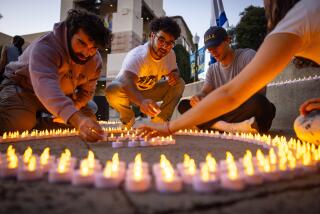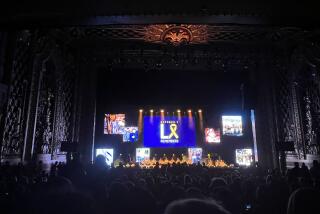Christians, Jews Celebrate Biblical Events
- Share via
For Sandy Krupinsky, the Palm Sunday celebration at Prince of Peace Episcopal Church in Woodland Hills brought together her deep faith in Jesus and her love of family.
“My parents went to church here and I grew up in this church,” said Krupinsky, of Agoura Hills. “Palm Sunday is part of the tradition of church and family that I want to give to my children.”
Nearby in Encino, Esther Pasternak was celebrating Purim, the Jewish holiday that commemorates the saving of the Jews from genocide in ancient Persia by a savvy young queen named Esther.
“Esther is a hero to me,” said Pasternak, 15. A member of Temple Ner Maarav in Encino, Pasternak was named for the Persian queen. “Esther was someone who defeated evil and saved her people from extermination. I feel good knowing that I was named after someone who was so strong.”
Although Palm Sunday and Purim commemorate two unrelated biblical events, they are similar in that they bring a sense of exaltation to the faithful.
The elation was evident Sunday as tens of thousands of Christians and Jews throughout Southern California gathered at churches and synagogues to celebrate.
The story of Jesus’ entry into Jerusalem on a path of palm fronds to the acclaim of crowds soon leads to Good Friday’s recounting of his trial and crucifixion. But the “passion,” or suffering, of Jesus ultimately yields on Easter to the happier story of resurrection from the dead.
Palm Sunday services thus convey an elated tone, however temporary, at the start of the holiest week of the Christian calendar.
At Prince of Peace Episcopal Church, members of the 300-family congregation, holding palm fronds aloft, lined the walkways as a procession of clergy, choir members and children ringing bells strolled triumphantly from the patio into the empty sanctuary.
Krupinsky’s daughter, Kyle, 10, seemed to understand how her mother felt.
“Palm Sunday to me means a lot of people being happy, leaving palms all over and Jesus coming into town,” she said.
For about 90 worshipers at the Culver City Presbyterian Church, Palm Sunday marked “the beginning of a week of focusing on the suffering of Christ,” said Pastor Thomas B. Robb. That meant extra attention to the plight of the community’s disadvantaged as congregants brought in cans of food for the hungry--”enough to fill a Cadillac-size trunk,” Robb said.
Synagogues generally began Purim observances with readings from the biblical Book of Esther and prayers on Saturday evening or early Sunday, but by late Sunday morning Judaism’s liveliest holiday was well under way with costume contests and carnival rides.
Known mainly for her beauty, Esther was no mere trophy wife. She bravely outed herself as a Jew to her love-besotted king in a successful bid to thwart palace plans for killing off the empire’s entire Jewish population.
The villain in the Esther story is Haman, the prime minister appointed by the Persian ruler Ahasuerus. Haman plotted to destroy all Jews when Mordecai the Jew refused to prostrate himself before him. Esther and Mordecai, her uncle, collaborated to defeat Haman, and the tables were turned when the prime minister was hanged on gallows he had built for Mordecai.
Purim holds special significance for Iranian Jews because Esther was from an area in ancient Persia that is now Iran and because she was willing to stand up for her people in the face of great personal danger, said Dr. Jacob Saleh, a member of Temple Ner Maarav.
“It is a holiday that shows that Iranians were involved in Judaism from the beginning,” Saleh said.
Jews have lived in what is now Iran for 2,500 years, ever since Cyrus the Great, the founder of the Persian empire, conquered Babylonia and invited freed Jewish slaves to live in Persia. However, Islam remains the dominant religion, with Jews making up about 2% of the population.
Saleh said Iranian Jews can empathize with Esther because of their modern-day flight from persecution after the Iranian Revolution and the rise of Ayatollah Ruhollah Khomeini’s Islamic fundamentalist regime in 1979.
There are about 30,000 Iranian Jews in the Los Angeles area and about 300,000 in Southern California, most of whom fled here at the time of the revolution.
“After the change in the political system in Iran,” Saleh said, “I have learned that continuity in traditions is the most important factor in a community, a religion and society.”
Dart is a Times staff writer. Haynes is a correspondent. Times staff writer Eric Lichtblau also contributed to this article.
More to Read
Sign up for Essential California
The most important California stories and recommendations in your inbox every morning.
You may occasionally receive promotional content from the Los Angeles Times.













